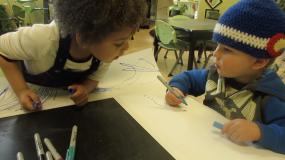Harper and Harrison Writing Together

Harrison and Harper, both three-years-old, are working in the studio with markers. As this episode begins, Harrison is slowly saying the letter names aloud as he writes his name, and Harper watches intently. We see that Harrison has already identified some of the regularities of written language. He knows that each letter name has a corresponding letter form (symbol). His writing also includes a knowledge of basic text conventions. Harrison writes distinct letter shapes, spaced apart, along a horizontal line (letter string), moving from left to right (directionality).
After Harrison finishes writing, he says, “I wrote my whole name.” The teacher responds, “You did!” By sharing with his teacher, Harrison shows he understands that letters can be combined to form words that communicate shared meaning. Children commonly begin writing by reproducing letters found in their own name; particularly the initial letter of their first name. Writing requires the child to engage in the process transcribing oral language into symbols. One’s name has personal significance. The meaning it holds likely supports Harrison as he undertakes the more technical work of making a spoken word into a graphic representation.
Interestingly, Harrison does not read aloud his name, or invite the teacher to read what he has written. Rather, he offers an interpretation of what his writing represents (“I wrote my whole name”). What may be noteworthy about writing his whole name? The name Harrison, comprised of three syllables and eight letters, is a fair challenge for an early writer and may inspire a warranted sense of accomplishment. Harrison may have recently also come to understand that each letter name corresponds to a unique letter form, and he wants to highlight his effort to represent each letter in his name. Perhaps he is sharing his holistic understanding that this is not simply a collection of letters, but the letters combine to form a word – a unit of language. We might further speculate that Harrison recognizes he has used a combination of conventional letters and invented letter-like forms. Children often write how they believe the letters may be composed. By identifying what he has written, Harrison might mean to convey, “this word includes placeholders for the letter forms I’m still learning.” In these ways young children actively work to make sense of the written and spoken language in their environment.
Harper offers Harrison her marker and asks, “Can you write my name?” The children nurture their friendship by relating to each other with kindness and respect. Harrison acknowledges her gesture as he gently replies, “I’m using this marker.” The trio begins a conversation about letters as Harrison asks if Harper’s name starts with an H. While Harrison has learned the letter name, he does not yet recognize the sound made by the letter H when spoken. Letter names often contain the sound symbolized by the letter (e.g, B, V, T) and thereby, can help young children infer the letter sounds. Other times, the sound-letter correspondence is not in agreement. As children work to understand the nature of language, they begin to identify these regularities and irregularities.
Harrison confidently writes the conventional letter H at the beginning of both his and Harper’s names. Inspired by her friend, Harper decides to draw letter shapes and she too writes a conventional letter H. Harper confirms that she knows the letter name for the letter shape that she wrote when she asks the teacher, “Does your name start with a H?”
Throughout the episode, the teacher gently supports the children’s letter writing. For example, when the similar spelling of his and Harper’s names causes Harrison to go back to spelling his own name, the teacher does not interject. Instead, Harrison is able to reflect on his spelling and ask for help, “Does she have two Hs”. The teacher points out that Harper’s name starts with the same three letters as Harrison’s name. This was not unintentional. In fact, the teacher intentionally formed a small learning group with Harper and Harrison because the two children have some of the same letters in their names. She intended to offer the children the opportunity to socially-construct knowledge about letters. The teacher says, “She has, H – A – R, just like you.” In doing so, she works to scaffold the children’s understanding that letters represent the sounds in spoken words in a systematic way.
The teacher supports the children’s writing by spelling out the letter names, H – A – R – P – E – R. We also hear the teacher use the letter P sound “pah, pah” to support Harper’s recognition of the letter P in her own name. When supporting young children learning to read, spell, and write, when do you think it is more helpful to emphasize letter names and letter sounds?
This lovely interaction between two young preschoolers and their teacher helps us consider the underlying knowledge that children must acquire while in the process of developing early literacy. In this example, we see that Harper’s paper has both scribbles, which is how she began the experience, and marks and letters, which is how she ended the experience. Her paper is a form of assessment, capturing the learning that has occurred through this experience and in partnership with Harrison and her teacher. Can you offer other examples where the children show what they know and give us an indication about what knowledge they may be working to acquire as they write together?
Run time: 1 minute 51 seconds
Keywords: threes, markers, children-object, early writing, peer scaffolding, literacy, teaching
